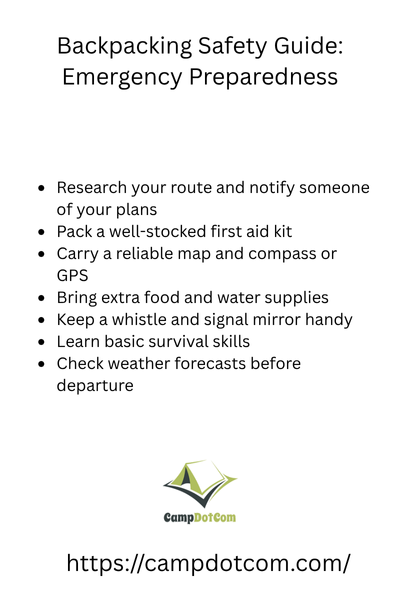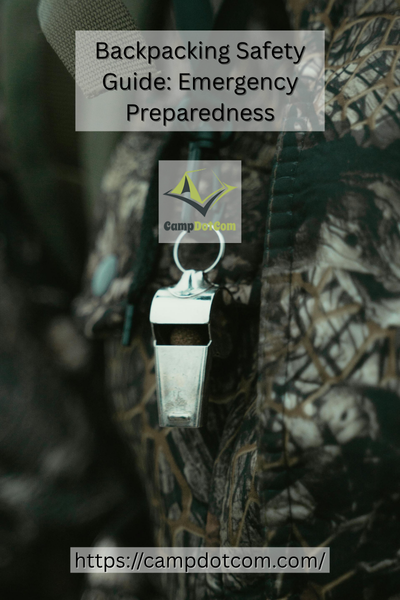If you are heading into the wild, this backpacking safety guide is something you will definitely want to keep in your back pocket. I have had my fair share of blisters, thunderstorms, and yes, one very cranky raccoon encounter. Trust me, being prepared is way more enjoyable than feeling panicked.
Read More About Backpacking Safety Guide

Why Emergency Preparedness Is Your New Best Friend
Look, I get it. When you are planning a backpacking trip, it is way more exciting to think about epic views and campfire meals than about what you would do if you sprained your ankle or lost your map. But here is the deal—things happen. That is why this backpacking safety guide is all about helping you stay safe while still having a great time.
A few years ago, I went on a solo trek in the Pacific Northwest. The weather app said clear skies, but surprise! By the second day, I was knee deep in fog with a dead phone and no GPS signal.
As an Amazon Associate, I earn from qualifying purchases. Some of the links in this article are affiliate links. This means that, at zero cost to you, I will earn an affiliate commission if you click through the link and finalize a purchase.
I had not packed a paper map which was definitely a beginner mistake. I had to rely on trail markers and my very shaky memory. I made it out fine, but it taught me a lesson I will never forget. The unexpected does not send a warning.
More Things to Know About Backpacking Safety Guide

Start with the Essentials
So let’s talk basics. Emergency preparedness starts before you even lace up your boots. You need to pack like a smart survivalist, not a panicked hoarder. Think compact, multipurpose, and essential.
A lightweight first aid kit, water purification tablets, backup navigation (yes, like an actual map and compass), and a headlamp with extra batteries? Non-negotiable.
Toss in an emergency blanket, a whistle, and some high-calorie snacks too. It’s like insurance—you hope you don’t need it, but when you do, you’ll thank your past self.
Tell Someone—Seriously
One thing I always, always do now is tell someone my plan. Not just “I’m going hiking,” but the full itinerary: trailhead, route, expected return time, and what to do if I don’t check in.
You don’t want to be the person search and rescue is looking for three days too late because you thought a quick text was enough.
This isn’t overkill—it’s part of real-world backpacking safety guide that can literally save your life. And if you’re going solo, double that effort. I even leave a copy of my route under the seat of my car at the trailhead. Overkill? Nope. Peace of mind.
Weather: The Wild Card
Weather can be sneaky. It changes quickly, and if you are hiking at a higher elevation, it can be even moodier. Do not depend on your phone app alone. Check forecasts from a few different sources, and always pack like the worst case scenario might happen. That means bringing rain gear, extra layers, and dry socks.
I used to laugh at the idea of carrying rain pants on a dry summer hike. You can probably guess how that turned out. Four hours later, soaked and freezing, I was doing the saddest little hike dance just to stay warm. I will not skip the rain pants again.
Practice Makes Confident (Not Perfect)
Do not just bring emergency gear. Make sure you know how to use it. Can you actually work that water filter or apply a tourniquet? What if you had to start a fire and everything around you was wet? Trying to figure it out in the dark when you are already tired is not the time to start reading instructions.
One important part of this backpacking safety guide is becoming familiar with your gear until it feels natural. Try things out in your backyard. Get some practice. Play a few “what if” games with your hiking friends. It might feel a little nerdy at first, but you will feel confident and ready when you know exactly what to do.
Mental Preparedness: Stay Cool
Let’s talk mindset. Panic is the enemy. Staying calm, focused, and flexible is half the battle. That’s why I always take a few minutes before setting off to check in with myself. Am I feeling good? Do I know the route? What’s my backup plan if things go sideways?
Confidence comes from preparation, not from pretending nothing can go wrong. When I got turned around on a foggy trail last fall, I didn’t freak out. I took a breath, sat down, ate a granola bar (fuel helps!), and pulled out my backup map. Ten minutes later, I was back on track.
Wrapping Up the Backpacking Safety Guide Emergency Preparedness Essentials
So, what is the takeaway from this backpacking safety guide? It is simple: nature is incredible, but it does not come with a safety net. Being prepared for emergencies is not about being scared. It is about feeling capable and confident.
You do not have to be Bear Grylls. But you do need to respect the unpredictability of nature and prepare like someone who values their life (and their legs) enough to plan ahead.
Next time you pack your bag, take a few extra minutes to ask yourself, “If something went wrong, would I be okay?” If the answer is yes, then you are on the right track.
Stay wild. But stay safe, too.
